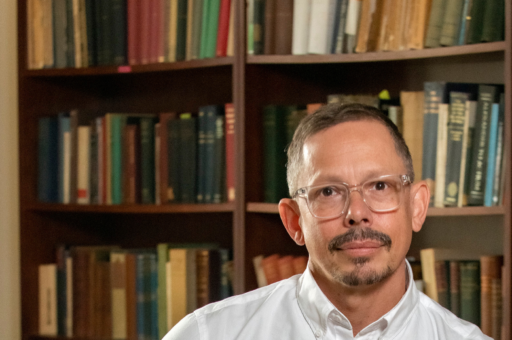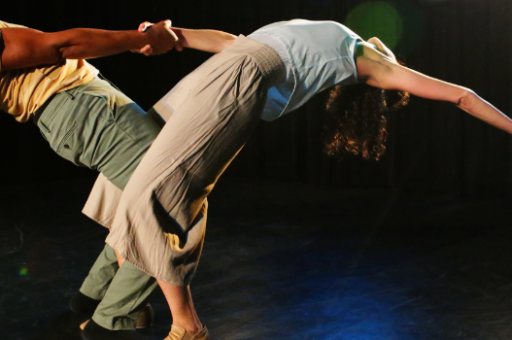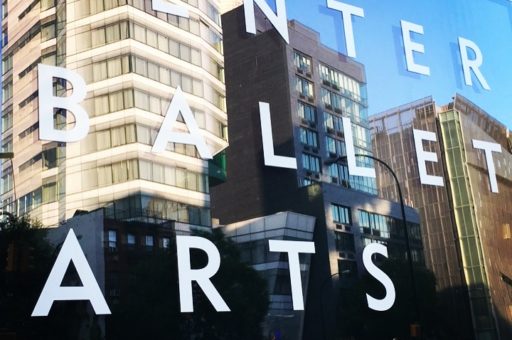Reid Bartelme and Harriet Jung (CBA ’17) founded Reid & Harriet Design in the Fall of 2011. Prior to meeting at the Fashion Institute of Technology, Bartelme spent 10 years working as a dancer, and Jung studied visual arts and completed a degree in Molecular and Cell Biology at UC Berkeley. Collaboratively, they have designed costumes for Justin Peck, Pam Tanowitz, Kyle Abraham, Pontus Lidberg, and Trey Mcintyre, among others. They have costumed dozens of productions for companies including American Ballet Theater, New York City Ballet, Hubbard Street Dance Chicago, the Malpaso Dance Company, Pacific Northwest Ballet, Miami City Ballet, and the Pennsylvania Ballet. Along with Justin Peck, they are featured in the documentary Ballet 422.
For more about Bartelme and Jung’s CBA Fellowship, visit their fellow page.
What were you working on before your fellowship? What brought you to CBA?
Prior to our time at CBA we were working on costume commissions for various dance companies, which makes up the bulk of our work. We also spent a lot of the year leading up to our residency working on a small swimwear line that we launched in Spring of 2017.
Please briefly describe your fellowship project.
Our project is a re-imagining of “The Nutcracker.” We wanted to explore what it feels like to tackle the designs for a full length ballet and we wanted to show what a production directed by designers would look like. It is a project that enables us to work outside the parameters of a choreographer’s ideas, and puts our ideas about story and aesthetics first.
How and why did you select The Nutcracker? Why did you choose to focus on the E.T.A. Hoffman story?
Not only is “The Nutcracker” a Ballet of unprecedented popularity, it also presents amazing opportunities for interpretation. We were very excited to tackle a story that is set in both reality and fantasy worlds. It is a story that is so often underserved in its Ballet iterations and we wanted to illuminate some of the more complex and emotional details from the E.T.A. Hoffman story, where Marie really struggles with what she believes to be true and what she is told to believe.

You have reversed the ballet production process by beginning with set and costume design rather than music or choreography. Why have you chosen this approach? Is there precedent for it?
It is not entirely accurate to say that we began with set and costume design. We began with the literature and the score. By understanding the stories by both Hoffman and Alexandre Dumas and looking at all the Petipa stage directions in the Tchaikovsky score, we were prepared to develop a version of the story that both honored the original literature and could fit into the framework of the score. It was after that when we began designing the visual components. Taking on the role of director meant that we took on the research and development aspects of the creation. These directorial duties would traditionally be the responsibility of the choreographer in the Ballet world. Once we started designing the costumes and sets, our ideas about the characters and story became more textured and complex, but our research gave us a framework to work within.
How did your choice to set your version of The Nutcracker in the 1950s influence your design choices? Is there a politics driving this choice?
Our designs for the first act were very much influenced by the colors, silhouettes, and textures of the 50’s. It was important for the costumes to be accurate, so we did sufficient visual research – from the clothing, to the toys, all the way down to the shoes. All this visual research informed not only our designs, but also some specific characters in our Nutcracker, like the vintage ‘Chicken of the Sea’ mermaid. Lastly, the 50’s laid down a good place of departure for the second act, where we really wanted to convey a setting without all the societal conventions. Politics are involved since we are explicitly trying to create a production with fewer gender conventions and more gender inclusive roles.
Your iteration of The Nutcracker addresses the fluidity of gender identity. Does that change the meaning of the piece?
Fluidity of gender identity is not the center of our Nutcracker. The central theme is the feeling of being other and wanting to break out of societal norms, which includes gender identity but also many other issues. It doesn’t change the meaning of The Nutcracker in the sense that this feeling of being an outsider is conveyed in the original story. We do acknowledge that this aspect of the original story hasn’t been as explicitly explored in most well-known productions of The Nutcracker. We felt it was important to do that while still creating an accessible production.

Have you made any unexpected discoveries during your time at CBA? What were they and how did they influence your work?
The staff provided us with some very interesting and informative feedback, which made us dig a little deeper into our decisions and ideas. Allan Macleod, the administrative aide (and much more), pointed out that the toys in the battle scene and a lot of our characters reminded him of the rapid rise of consumerism in the 50’s. This sort of brought the maybe subconscious to the conscious and made us think about our character choices and designs a little more, reinforcing some choices and not so much others.
How do you see your project evolving after the fellowship concludes? Will it be produced?
We hope to continue refining our Nutcracker and to have a complete production dossier, presentable to choreographers and dance companies. At this point, there are no concrete plans for this to be produced, but we are clearly open to that possibility.





